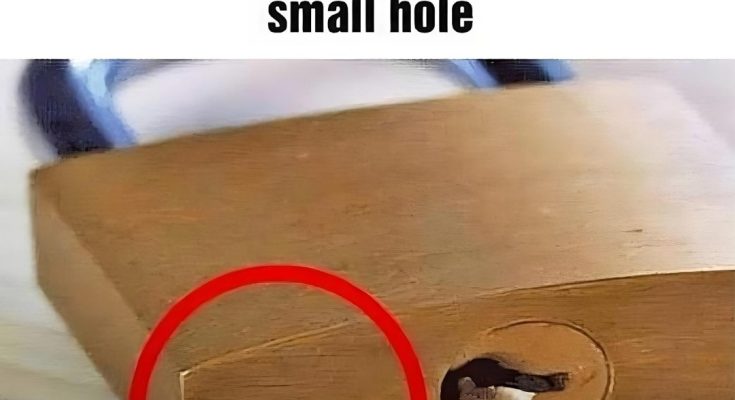Padlocks are everywhere, from securing gates and bikes to locking up toolboxes. While they serve a straightforward purpose—keeping our belongings safe—there’s more to these metal devices than meets the eye. If you’ve ever noticed the tiny hole at the bottom of a padlock, you might be surprised to learn it’s not just a design quirk. That small hole actually serves a vital function, enhancing the padlock’s performance and longevity. Let’s take a deeper dive into why it’s there and explore other common objects that hide surprisingly useful features.
The Essential Role of the Small Hole on Padlocks
One of the most overlooked features of a padlock is the tiny hole located at its bottom. Although it might seem trivial, this small hole plays an important role in maintaining the lock’s integrity and usability over time.
1. Preventing Rust and Corrosion
Padlocks are often exposed to the elements, whether they’re used on outdoor gates, bike chains, or storage sheds. Water and moisture can easily enter a padlock, which increases the risk of rust and corrosion. Left unchecked, this can shorten the lifespan of the lock. The small hole at the bottom acts as a drainage system, allowing water to escape instead of collecting inside. This prevents the buildup of moisture, which could otherwise damage the internal mechanisms and weaken the padlock’s structure. By draining the water out, the hole helps preserve the padlock, ensuring it lasts longer.
2. Providing an Entry Point for Lubrication
Ever had a padlock that just wouldn’t open, even with the correct key or combination? Padlocks can become stiff or stuck, especially after exposure to weather or prolonged disuse. This is another time when the tiny hole comes in handy. You can use the hole to apply a lubricant, such as WD-40, which will help loosen the internal parts and allow the lock to function smoothly again. This little trick can save you a lot of time and frustration, making it easier to access your secured belongings.
Modern Alternatives to Traditional Padlocks
While the drainage hole is a smart feature, padlock designs have continued to evolve. Today, some manufacturers offer waterproof padlocks, built to withstand even more extreme conditions without rusting or corroding. These advanced locks use materials and coatings that repel water entirely, eliminating the need for a drainage hole. If you need a padlock for outdoor use in harsh conditions, a waterproof model could be worth the investment.
Other Everyday Objects with Hidden Features
Padlocks aren’t the only items with hidden functionalities. Many everyday objects we use regularly come with clever design elements that often go unnoticed. Here are a few examples:
1. Screwdrivers with Built-In Wrench Functionality
Most screwdrivers have a hexagonal base at the handle, which allows them to fit into a wrench. This gives you extra torque, making it easier to loosen tight screws. The next time you’re working on a project, keep this in mind—it might save you a lot of effort.
2. Fabric Swatches on New Clothing
You’ve probably seen small fabric swatches included with new clothes. These aren’t just for testing detergents. They also allow you to find an exact color match for repairs, ensuring your clothing stays in top condition. These swatches are also great for testing how different cleaning products affect your garments before using them on the whole item.
3. Brass Doorknobs: A Hygienic Choice
Brass is a popular material for doorknobs, not just for its durability but also for its natural antimicrobial properties. Brass can kill bacteria over time, making it a hygienic choice for high-touch surfaces like doorknobs and railings. It’s a subtle but effective way to reduce the spread of germs in public spaces.
4. The Gas Gauge Arrow
Forgetting which side your car’s gas tank is on can be a hassle, especially when driving a new vehicle. Fortunately, most modern cars have a small arrow next to the gas gauge on the dashboard, indicating which side the gas tank is located. This simple feature is often overlooked but incredibly helpful.
5. Heinz Ketchup’s “57” Label
Have you ever struggled to get ketchup out of a bottle? The “57” label on Heinz ketchup bottles isn’t just decorative—it’s a target. Tapping the bottle at the “57” mark helps get the ketchup flowing, saving you from shaking the bottle endlessly.
Hidden Features Add Value to Everyday Items
The hidden features in common objects aren’t just gimmicks—they’re designed to make our lives easier. These little details add value and functionality, demonstrating the thoughtful design that goes into even the simplest tools we use daily. By understanding these hidden elements, we can use these objects more efficiently.
Conclusion: Appreciating the Clever Design of Everyday Items
It’s easy to overlook everyday objects like padlocks, but taking a closer look reveals the clever design that makes them so effective. The small hole at the bottom of a padlock might seem insignificant, but it plays a crucial role in maintaining the lock’s longevity and functionality. Similarly, other objects—like screwdrivers, doorknobs, and ketchup bottles—come with hidden features that improve their usability. The next time you use one of these items, take a moment to appreciate the thoughtful design that makes your life just a little easier.



